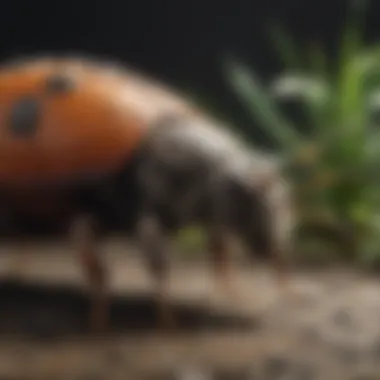Strategies for Optimal Perimeter Pest Control Services in Residences and Businesses


Preventive Pest Control Strategies
Yard Maintenance plays a pivotal role in creating a pest-free zone around the property. Engaging in essential yard care routines like regular mowing, trimming bushes, and removing standing water helps in deterring pests. Additionally, implementing methods like proper waste disposal, watering plants in the morning, and identifying potential pest breeding grounds contribute to a pest-resistant yard environment. As an extension of outdoor care, Indoor Cleanliness should not be overlooked. Expert cleaning tips and techniques focusing on maintaining a clutter-free, well-ventilated space will deter pests from seeking harborage indoors.
Garbage Disposal is a critical element in pest prevention. Efficient waste disposal methods involve sealing garbage bins tightly, disposing of food waste properly, and scheduling regular trash pickups. Stressing the importance of proper garbage disposal for both health and pest control reasons reinforces the need for responsible waste management. Moving on to Other Pest Prevention Strategies, homeowners can explore innovative ways to safeguard their homes using deterrents like ultrasonic pest repellents, natural herbs in the garden, or installing mesh screens on windows and doors.
Identifying Pest Risk Areas
After establishing preventive measures, it is essential to identify pest risk areas within and around the property. Beginning with Moisture Prone Areas Inspection, homeowners should proactively identify sources of moisture that attract pests like mosquitoes and termites. Implementing tips for preventing infestations includes fixing leaky pipes, clearing clogged gutters, and ensuring proper ventilation in moisture-prone areas. Crack and Crevice Inspection Guide underscores the importance of inspecting access points like wall cracks, window sills, and door frames. Strategies for sealing such openings with weatherproof sealants or caulking materials are crucial in preventing pest ingress.
Greenery Inspection for Pest Risks emphasizes understanding the impact of plant life on pest attraction. Maintaining a well-trimmed yard, removing dead plants, and planting pest-repelling shrubs contribute to a less hospitable environment for pests. Homeowners are urged to follow guidelines to upkeep pest-free yards, such as pruning trees away from the house and avoiding over-watering plants. Additional Pest Risk Areas may include spaces like attics, basements, or crawl spaces that require timely inspections especially during seasonal changes for increased pest activity.
Effective Pest Control Methods
Transitioning from prevention to actual pest control methods is vital in maintaining a robust barrier against potential infestations. Natural Repellents for Pest Control offer safe and effective alternatives to chemical solutions. Utilizing essential oils like peppermint, lavender, or eucalyptus not only repels pests but also adds a pleasant aroma to the living space. Observing safe usage practices with Chemical Sprays for Pest Control ensures effective pest eradication while minimizing health risks. Professional-grade sprays should be handled with care and applied as per instructions.
Pest Traps are a valuable tool in capturing and removing pests discreetly. Setting up traps following pest movement patterns and regular checks ensure swift removal of unwanted visitors. Biological Control Methods for Pest Prevention involve deploying natural predators like ladybugs for aphid control or nematodes for grub eradication in the soil. These environmentally friendly techniques provide a balanced approach to pest management. To complement traditional methods, homeowners can explore Other Pest Control Methods like the use of diatomaceous earth, sticky traps, or electronic pest repellers for a comprehensive pest control strategy.
Pest Species Identification
Recognizing common pest species is essential in crafting targeted control strategies. When dealing with Common Insects in Home Pest Control, it's critical to identify and manage infestations promptly. Ant baits, cockroach traps, and spider repellents are common remedies tailored to specific insect types. Understanding the behavior of these insects aids in selecting the appropriate control measures. Identifying Rodents for Pest Prevention involves recognizing signs of rodent activity like gnaw marks, droppings, or nesting materials. Implementing preventive measures such as sealing entry points and storing food in airtight containers can deter rodent infestations.
Bird species can also impact home environments negatively. Addressing bird-related issues requires humane strategies like bird spikes, nets, or sound deterrents. Troublesome bird species such as pigeons or starlings may need specialized control methods to minimize property damage and health risks. Dealing with Wildlife on Your Property necessitates understanding the behavior of wildlife species like raccoons, squirrels, or skunks. Implementing control measures like securing trash bins, removing attractants, and sealing off entry points can deter unwanted wildlife encounters effectively.
Miscellaneous Pest Species Identification encompasses managing lesser-known pests like silverfish, pantry moths, or carpet beetles. Identifying unique behaviors and nesting preferences of these pests aids in devising appropriate control strategies tailored to specific challenges.
DIY Pest Control Techniques
For homeowners keen on do-it-yourself solutions, DIY Pest Control Techniques offer an array of options that are cost-effective and environmentally friendly. Homemade Pest Control Solutions utilizing ingredients like vinegar, baking soda, or citrus oils provide natural alternatives to chemical pesticides. Crafting homemade remedies empowers homeowners to control pests while minimizing their impact on the environment.
Using Essential Oils for Pest Control serves as a fragrant and effective means of repelling pests from the home environment. Creating essential oil blends like citrus and cedarwood or peppermint and tea tree oil can deter pests while promoting a calming atmosphere. Effective Pest Traps and Barriers, such as sticky traps for crawling insects or physical barriers to block entry points, offer non-invasive methods of pest control. By setting up these traps strategically and monitoring them regularly, homeowners can identify and mitigate pest issues promptly.
Top Reputable Pest Control Brands provide access to professional-grade products renowned for their efficacy in managing pest infestations. Choosing products from trusted brands ensures quality control and reliable results in safeguarding the home. Homeowners are advised to consult with pest control professionals or refer to reputable sources for product recommendations tailored to their specific pest control needs.
Lastly, Miscellaneous DIY Pest Control Techniques encompass out-of-the-box solutions for addressing various pest issues at home. Strategies like using ultraviolet traps for flying insects, deploying botanical dust for crawling pests, or installing door sweeps for rodent exclusion demonstrate the diversity of DIY pest control methods available to homeowners.


Introduction
In the realm of property management, the realm of pest control services plays a critical role in ensuring the sanctity and safety of residential and commercial spaces. Pests can wreak havoc on structures, pose risks to health, and result in significant financial losses if left unattended. This article peels back the layers of perimeter pest control services, shedding light on the strategies and techniques employed to effectively combat pest infestations surrounding properties.
Understanding the granular details of proactive pest management is paramount to safeguarding one's living or working environment from the perils of pests. From termites silently chomping through wooden structures to rodents carrying diseases, the stakes are high when it comes to pest control. By delving into the essence of perimeter pest control, individuals can equip themselves with the knowledge needed to protect their spaces from unwanted intruders.
Furthermore, in a world that is increasingly leaning towards eco-conscious practices, the importance of eco-friendly solutions in pest control cannot be overstated. Adopting greener approaches towards pest management not only safeguards the environment but also promotes the well-being of inhabitants. By amalgamating the principles of effective pest control with environmentally friendly practices, property owners can create a harmonious living and working space free from the clutches of pests.
Moreover, this comprehensive guide acts as a beacon of insight for individuals seeking to navigate the intricate landscape of perimeter pest control services. From the nuanced strategies of inspection and assessment to the intricate dance of exclusion techniques, this article aims to unravel the complexities surrounding pest management with a focus on the perimeter of properties.
By immersing oneself in the world of perimeter pest control services, individuals can embark on a journey towards fortifying their properties against the infiltration of pests. This article strives to serve as a roadmap, guiding readers from the initial steps of pest detection to the implementation of effective control measures, culminating in the enjoyment of pest-free cocoons where peace and security reign supreme.
Importance of Effective Pest Control
In the realm of property management, the significance of effective pest control cannot be overstated. As we delve into this article focusing on the various strategies and methods to maximize the effectiveness of perimeter pest control services, it is vital to understand why proactive pest management is crucial. The preservation of property integrity stands as a paramount concern for homeowners and commercial property owners alike. Pest infestations can wreak havoc on the structural integrity of buildings, causing damage to walls, foundations, and other vital components. By implementing stringent pest control measures, individuals can protect their properties from physical deterioration, saving them from costly repairs and maintenance.
Preserving Property Integrity
Preserving property integrity is not merely a matter of aesthetics but a fundamental aspect of maintaining a safe and habitable environment. When pests infiltrate a property, they often target vulnerable areas such as wooden structures, insulation, and wiring, compromising the overall integrity of the building. Termites, for instance, can silently devour wooden beams, posing a serious threat to the structural stability of a home. Rodents can gnaw through electrical wiring, increasing the risk of fire hazards. By prioritizing effective pest control measures, property owners can safeguard their investments and ensure the long-term durability of their buildings.
Ensuring Health and Safety
Beyond property damage, pest infestations also pose significant risks to human health and safety. Pests like cockroaches, rodents, and mosquitoes can carry a host of pathogens and contribute to the spread of diseases. Cockroach allergens can trigger respiratory issues, while rodent droppings can transmit illnesses such as leptospirosis and hantavirus. Additionally, stinging insects like bees and wasps can cause allergic reactions in individuals, leading to potentially life-threatening situations. By maintaining a proactive approach to pest control, property owners can create a healthier and safer living environment for themselves and their families.
Avoiding Financial Losses
In the realm of property management, financial considerations play a significant role in decision-making processes. Pest infestations can result in substantial financial losses for property owners. The cost of repairing damage caused by pests, coupled with the expenses related to eradicating infestations, can quickly escalate. Moreover, pest-related issues can tarnish a property's reputation and diminish its market value. By investing in effective pest control measures, property owners can mitigate these financial risks and preserve the value of their assets. Preventative pest management serves as a cost-effective approach to safeguarding financial investments and ensuring long-term prosperity.
Understanding Perimeter Pest Control
In the realm of pest management, understanding perimeter pest control plays a pivotal role in safeguarding residential and commercial properties. It is imperative to delve into the nuances of this aspect to comprehend the significance of implementing effective strategies. By focusing on Understanding Perimeter Pest Control in this article, readers can gain valuable insights into how to fortify their spaces against potential infestations, ensuring a harmonious and pest-free environment. Through a detailed exploration of specific elements, benefits, and considerations surrounding perimeter pest control, individuals can equip themselves with the knowledge necessary to protect their properties proactively and comprehensively.
Definition and Scope
When we discuss the Definition and Scope of perimeter pest control, we are essentially defining the boundaries within which pest management activities are conducted. The definition delves into the methodologies and practices involved in creating barriers to prevent pest intrusion effectively. The scope, on the other hand, outlines the extent of coverage and protection that perimeter pest control can offer to a property. Understanding the Definition and Scope is essential for establishing a clear framework for implementing pest control measures and delineating the areas that require protection.
Benefits of Perimeter Pest Control


The benefits of perimeter pest control extend far beyond mere pest eradication - they encompass a holistic approach to property protection and preservation. By embracing perimeter pest control, individuals can safeguard the integrity of their properties, mitigate health and safety risks associated with pest infestations, and avert potential financial losses stemming from pest-related damages. Additionally, effective perimeter pest control contributes to promoting a sustainable and environmentally friendly living or working environment, enhancing the quality of life for inhabitants.
Common Pests Targeted
In the realm of perimeter pest control, various common pests are targeted to ensure comprehensive protection against infestations. These include but are not limited to ants, rodents, termites, mosquitoes, and spiders, among others. Each pest poses unique threats to properties, making it essential to tailor pest control strategies to address specific infestation risks. By identifying and targeting common pests through perimeter pest control, individuals can effectively mitigate the proliferation of these unwanted intruders and maintain a pest-free living or working space.
Effective Strategies for Perimeter Pest Control
Effective strategies for perimeter pest control play a crucial role in ensuring the efficacy of pest management efforts around residential and commercial properties. By strategically implementing a combination of methods, property owners can effectively mitigate pest infestations and safeguard their spaces. The key benefits of focusing on effective strategies for perimeter pest control include long-term pest prevention, reduced reliance on harmful chemicals, and enhanced overall property protection.
1. Inspection and Assessment
Inspection and assessment are fundamental components of effective perimeter pest control. Thoroughly inspecting the property allows professionals to identify existing pest infestations, vulnerable entry points, and potential attractants. Assessment helps in tailoring a targeted pest management plan that addresses specific pest issues. Regular inspections enable early detection of pest problems, preventing infestations from escalating and minimizing the need for extensive pest control measures.
2. Exclusion Techniques
Exclusion techniques are essential for preventing pests from entering structures and outdoor areas. This approach involves sealing cracks, gaps, and openings that serve as entry points for pests. Installing door sweeps, using screens on windows, and sealing gaps around utility penetrations are effective exclusion techniques. By creating physical barriers, property owners can significantly reduce the likelihood of pest ingress and establish a proactive defense against unwelcome intruders.
3. Environmental Modifications
Environmental modifications contribute significantly to the success of perimeter pest control. By optimizing the surroundings of a property, individuals can deter pests from establishing habitats near buildings. Strategies such as minimizing standing water, maintaining proper landscaping practices, and reducing clutter eliminate factors that attract pests. Creating a less hospitable environment for pests through environmental modifications acts as a preventive measure, discouraging pest activity and minimizing the need for extensive pest control interventions.
4. Chemical Barriers
Chemical barriers are a valuable tool in perimeter pest control when used judiciously and in conjunction with other strategies. Applying insecticidal barriers around the perimeter of a property creates a protective shield against crawling insects and other pests. Utilizing low-toxicity formulations minimizes environmental impact while effectively controlling pest populations. Implementing chemical barriers as part of an integrated pest management approach enhances the overall effectiveness of pest control measures, contributing to long-term pest prevention and property protection.
Implementing Eco-Friendly Pest Control Solutions
In the realm of perimeter pest control services, implementing eco-friendly solutions is a pivotal aspect that resonates with the increasing awareness towards sustainability and environmental consciousness. This section delves into the core significance of prioritizing eco-friendly practices within the broader context of pest management strategies detailed in this comprehensive guide. By emphasizing the utilization of eco-friendly pest control solutions, individuals and property owners can not only effectively combat pest infestations but also contribute positively to the ecosystem.
Benefits of Eco-Friendly Approaches
Eco-friendly approaches in pest control offer a multitude of benefits that resonate with both environmental and human safety concerns. Unlike traditional chemical-based pesticides that can have harmful impacts on the environment and human health, eco-friendly solutions leverage natural ingredients that pose minimal risk to non-target species and the ecosystem. Embracing eco-friendly pest control approaches can enhance air and water quality while promoting a healthier living environment for inhabitants. Furthermore, these methods are sustainable in the long run, reducing the carbon footprint associated with pest control activities.
Natural Repellents and Deterrents
Natural repellents and deterrents play a crucial role in eco-friendly pest control solutions. By utilizing ingredients such as essential oils, vinegar, diatomaceous earth, and citrus extracts, individuals can ward off pests without exposing themselves to harmful chemicals. These natural alternatives not only repel pests effectively but also leave behind a pleasant scent, unlike the strong and lingering odors associated with synthetic pesticides. Additionally, natural repellents are biodegradable, posing minimal risk to the environment and wildlife.


Biological Controls
Biological controls offer a sustainable and eco-friendly approach to managing pest populations by utilizing natural predators, parasites, and pathogens to keep pest numbers in check. This method harnesses the power of biological agents to maintain a balance in the ecosystem, reducing the need for chemical interventions. By introducing beneficial organisms that prey on pests or disrupt their life cycle, biological control strategies can target specific pest species while preserving the natural equilibrium of the environment. Incorporating biological controls into pest management plans adds a layer of complexity and effectiveness that aligns with eco-friendly practices.
Factors Influencing Pest Infestations
Understanding the factors that influence pest infestations is crucial in effectively managing and preventing pest problems around residential and commercial properties. By delving into these influences, property owners can proactively take steps to mitigate risks and protect their spaces. These factors play a significant role in determining the likelihood and severity of pest infestations, impacting the overall effectiveness of perimeter pest control services.
Climate and Seasonal Variations
Climate and seasonal changes are key determinants of pest activity. Fluctuations in temperature, humidity, and precipitation levels can directly affect pest population dynamics and behavior. For instance, warmer seasons often provide optimal conditions for various pests to thrive, leading to increased infestation risks. Understanding how climate patterns influence pest behavior is essential for implementing timely and targeted control measures to combat seasonal fluctuations in pest activity.
Landscaping and Structural Design
The landscaping and structural design of a property can significantly influence pest infestations. Landscaping features such as dense vegetation, overgrown plants, and standing water sources can create ideal habitats for pests, offering shelter and food sources. Additionally, structural vulnerabilities such as cracks, gaps, and improperly sealed entry points provide easy access for pests into buildings. By assessing and addressing landscaping and structural design aspects that attract or facilitate pests, property owners can create a less hospitable environment, thereby reducing the risk of infestations.
Property Maintenance Practices
Effective property maintenance practices are essential for deterring pests and minimizing potential infestation risks. Regular inspection, cleaning, and upkeep of the property help identify and address issues that could attract or harbor pests. Maintenance tasks such as proper waste management, sealing off entry points, and repairing damaged structures play a critical role in pest prevention. By establishing robust property maintenance routines, property owners can create a less hospitable environment for pests, reducing the likelihood of infestations and enhancing the overall effectiveness of perimeter pest control services.
Collaborating with Pest Control Professionals
Choosing the Right Service Provider
Selecting the right pest control service provider is a decision that requires careful consideration. When choosing a service provider, it is essential to look for companies with a solid reputation, years of experience, and relevant certifications. Additionally, verifying the effectiveness of the products and techniques used by the service provider is crucial in ensuring successful pest control outcomes. Reading reviews, asking for recommendations, and conducting thorough research will help in identifying a reputable and dependable pest control partner.
Customized Pest Management Plans
Customized pest management plans are tailored solutions designed to address the specific pest control needs of a property. These plans take into account factors such as the type of pests present, the extent of infestation, and any unique characteristics of the property. By creating customized management plans, pest control professionals can maximize the efficacy of their treatments and minimize the risk of future infestations. Property owners should work closely with their service provider to ensure that the pest management plan aligns with their goals and preferences.
Regular Monitoring and Follow-Up
Regular monitoring and follow-up are essential components of effective pest control management. After implementing initial treatments, pest control professionals should conduct regular inspections to assess the effectiveness of the measures taken and make any necessary adjustments. By monitoring pest activity and addressing any emerging issues promptly, property owners can maintain a pest-free environment in the long term. Follow-up sessions also offer an opportunity to evaluate the success of the pest management plan and make recommendations for ongoing maintenance and prevention strategies.
Conclusion
In the realm of perimeter pest control services, the conclusion serves as the critical endpoint where all strategies and considerations converge to ensure the optimal protection of residential and commercial properties. This conclusive phase acts as the culmination of proactive measures, eco-friendly solutions, and collaborative efforts with pest control professionals, guaranteeing a comprehensive shield against unwanted intruders – both seen and unseen.
One of the central elements highlighted in this article’s conclusion is the holistic approach required in combating pest infestations. It underscores the interconnectedness of various strategies, such as inspection, exclusion techniques, environmental modifications, and chemical barriers, in creating a robust defense system against pests. By intertwining these methodologies seamlessly, property owners can establish a formidable perimeter that deters invaders effectively.
Moreover, the benefits underscored in the conclusion area extend beyond mere protection against pests. They delve into the preservation of property integrity, the promotion of health and safety standards, and the mitigation of financial losses that could arise from unchecked pest populations. These advantages underscore the multifaceted nature of perimeter pest control services and reiterate the proactive stance necessary for property owners to maintain a pest-free environment.
In summary, the conclusion section encapsulates the overarching theme of this guide – resilience through knowledge and preparation. By heeding the insights shared throughout the article, property owners can not only address present pest issues but also fortify their defenses against future incursions. The conclusive segment echoes the underlying message of empowerment and proactive engagement in pest management, empowering readers to take charge of their spaces and ensure lasting protection against potential threats.



